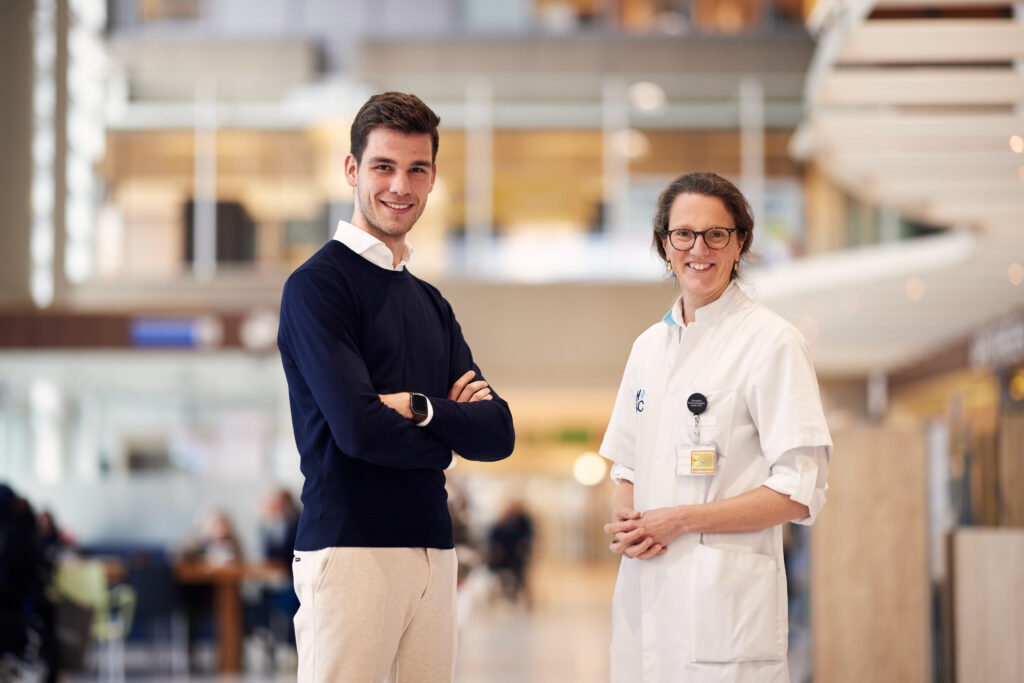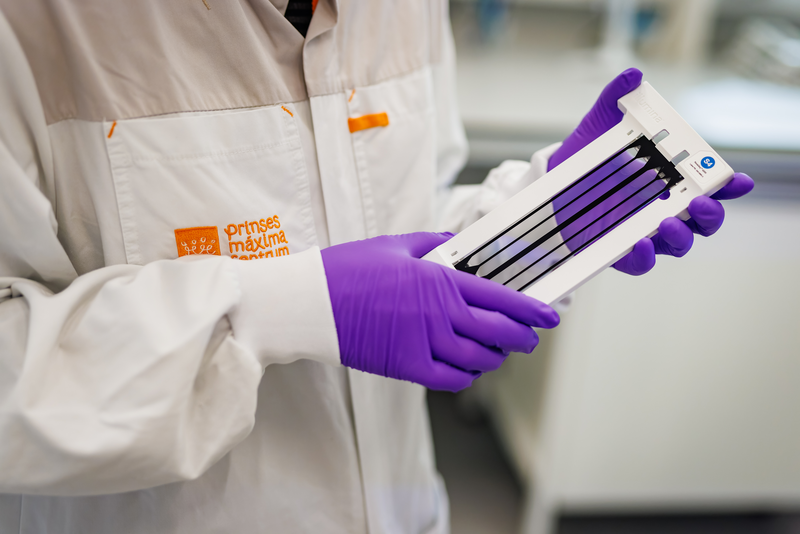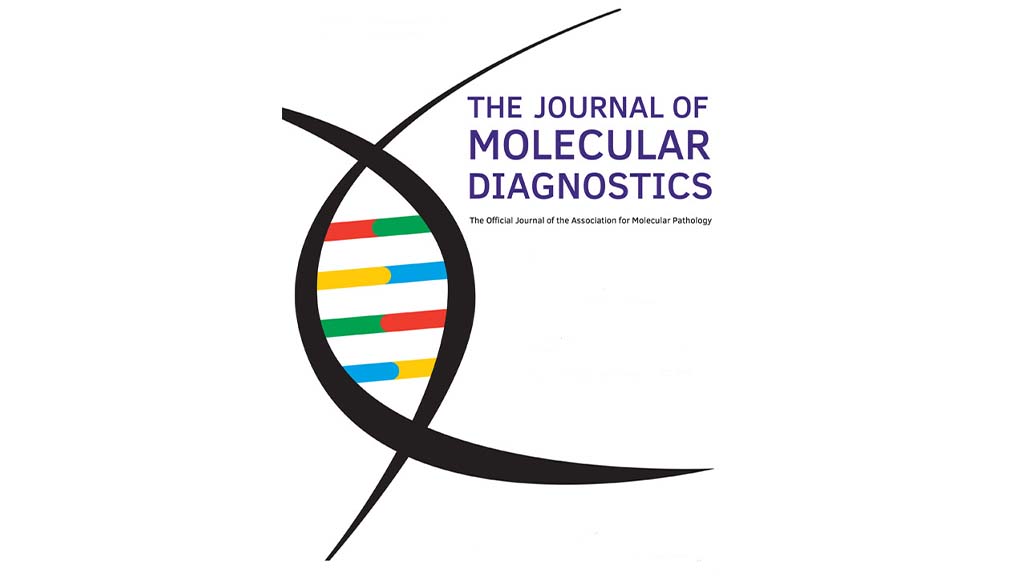GLOW: working toward more treatment options for glioblastoma

The outlook for patients with glioblastoma has been unfavorable for years, and treatment options remain limited. That is a reason for the GLOW study to make use of complete DNA analysis to search for new treatments, in collaboration with Oncode Institute and Hartwig Medical Foundation. GLOW researchers Marike Broekman and Mark van Opijnen: ‘We believe that this form of diagnostics is the future of oncology.’
Text: Koen Scheerders
Glioblastomas are the most common malignant primary brain tumors. In the Netherlands, they affect about 1,100 patients annually. The outlook for these patients is unfavorable – two years later, less than a fifth of these patients are still alive. Treatment of glioblastoma has hardly changed in recent years. Despite intensive chemotherapy and radiotherapy, median survival is only 15 months after diagnosis.
GLOW study
The GLOW (Glioblastoma Targeted Treatment Option Maximization by Whole Genome Sequencing) study is an investigation into new targeted and personalized treatments, based on the tumor’s genetic profile in patients with recurrent glioblastoma. The hope is that this paves the way for new targeted treatments. These are badly needed, says Marike Broekman, neurosurgeon at Haaglanden Medical Center and Leiden University Medical Center, and principal investigator of the GLOW study. ‘The patients with glioblastoma that I do surgery on have often died after little more than a year. We have our backs against the wall.’
The course of illness is the same in all patients, illustrating the need for better treatment options, Broekman says. ‘There is a lot of room for improvement. That may lie in new targets for which we can find targeted therapies. Whole Genome Sequencing (WGS) can help identify new targets so we can use them for better-tailored treatment.’
Which patients?
Eventually, the tumor recurs in every patient after treatment, Broekman says. ‘We perform brain surgery to remove tumor tissue, but unfortunately, we can never remove all glioblastoma cells.’ Afterward, patients receive six weeks of radiation and chemotherapy, followed by another six months of chemotherapy. ‘Everyone gets the same treatment,’ Broekman says, ‘even if we know it doesn’t work.’
Patients who have had previous surgery, in whom the tumor has recurred, and who are eligible for a second surgery, can participate in the GLOW study. But for that, the expected quality of life must remain acceptable, Broekman says. ‘Brain surgery is intensive. A loss of function is not inevitable. Most importantly, we must keep in mind that a patient has a limited life expectancy. We want them to be able to spend the time they have left as happy as possible.’
Enthusiasm
In total, 12 hospitals are participating in the GLOW study. These are all the major Dutch neuro-oncology centers where the surgery takes place, plus the centers that do the post-treatment – all seven university medical centers, the Antoni van Leeuwenhoek, the Elisabeth-TweeSteden Hospital, Haaglanden Medical Center, Isala and Medisch Spectrum Twente. ‘It is very nice to see the cooperation between all these centers that offer treatments around glioblastoma,’ says Mark van Opijnen, resident (not in training) in neurosurgery and GLOW study researcher. ‘We are sensing great enthusiasm among researchers and practitioners, as well as patients, hoping that this research will enable new treatments. When a glioblastoma has grown back, median survival is only a few months. A new treatment can hopefully lengthen a patient’s life significantly.’
Since the beginning of the GLOW study in 2022, Haaglanden Medical Center was the first participating hospital that started patient inclusion. Since then, the study has been running in most of the 12 centers. In total, 28 patients have had their tissue collected and analyzed. ‘We had a long start-up phase before the study could open,’ Broekman explains. ‘The percentage of operable patients varies by the hospital from 5 to 30 percent of all patients with glioblastoma. With 1100 new diagnoses per year, it is a rare disease.’
Delivery
Broekman hopes the GLOW study will demonstrate the added value of WGS in recurrent glioblastomas. ‘We hope to find druggable targets that we would not have been found otherwise, and that may lead to a different treatment of glioblastoma.’ But on the research front, too, he hopes the GLOW study will bear fruit. ‘We will soon have a lot of WGS data from these patients, not only enabling us to learn from the tumor but also telling us whether it makes sense to do more of these diagnostics in this setting.’
Van Opijnen likes that latter thought. ‘During surgery, we look at the tumor structure. The pathologist then examines the tissue. The logical next step would be to use WGS within that tissue to look at the DNA.’ Detailed tissue analysis with WGS is new, says Van Opijnen. ‘With this, we are pulling out all the stops in terms of diagnostics to maximize treatment options. We see that patients find that idea appealing. That’s what we’re doing our research for as well.’
Mark van Opijnen
‘We will soon have a lot of WGS data from these patients, not only enabling us to learn from the tumor but also telling us whether it makes sense to do more of these diagnostics in this setting.’
Challenges
The biggest current challenge of the GLOW study is the connection to the DRUP study, Broekman says. ‘In patients who have had surgery, especially those with complete tumor resection, we can see no more tumor material on a brain scan. But we do know there are cells lingering, causing the tumor to grow back eventually.’ In these patients, WGS could form an option to find new druggable targets. However, because the disease is not measurable at this point, the patient is not eligible for any drugs in the DRUP study. ‘We feel that if we were to delay treatment, we would not be providing good care,’ Broekman says. ‘Discussions with DRUP are ongoing and we hope to find a solution. There should be different criteria for these types of tumors because they are different. Otherwise, techniques like WGS will keep producing results that we wouldn’t be able to put into practice.’
Marike Broekman
‘The hope is that this paves the way for new targeted treatments.’
A second challenge is translating WGS results to the patient. ‘It is difficult for a patient to understand a WGS report, especially if a practitioner does not know either,’ says Van Opijnen. ‘But we believe this form of diagnosis is the future in oncology. That is why we want to push for education, so that not only neurologists and neurosurgeons, but everyone involved in the care of these patients, can get better at interpreting and using these results.’ There is much room for improvement in this area, Broekman adds. ‘We notice how eagerly all practitioners and patients are involved and want to learn from the results. That’s a good drive.’
Learning more
Van Opijnen hopes that the data from the GLOW study will teach researchers and practitioners more about glioblastoma as a phenomenon. ‘The more you learn, the better you can adapt a treatment strategy. Hopefully, this study will grant us insight into the behavior of this tumor and important underlying factors. ‘It’s a field in motion’, Broekman says. ‘Thanks to this study, knowledge is increasing. That may lead to yet another new study, for example in patients who have just been diagnosed with glioblastoma. Hopefully, this will put us on the path to more personalized treatment, instead of the treatment we now give to everyone.’
‘I’m glad I get to do this kind of work for the patients with glioblastoma,’ Broekman concludes. ‘This type of cancer is rare, but it can affect anyone. Survival is very low. That is why I am incredibly grateful to Oncode Institute for making this study possible. We are curious to see what the study yields. In any case, we are learning from it. That will certainly benefit future patients.
The GLOW study was funded by Oncode Institute through the Clinical Proof of Concept fund. The fund is part of Oncode’s Link to the Clinic programme, which aims to bridge the gap between researchers, patients and the clinical world, enabling collaboration, learning and the translation of promising research findings into clinical solutions.
More information
- Everything about the GLOW study
- Interview with Ann Hoeben, medical oncologist MUMC+ and participant in the GLOW study
- GLOW study protocol
Also read

Collaboration for future-proof diagnostics and to accelerate research
Complete analysis of the DNA of children with cancer offers many possibilities. It maps out all possible targeted treatment options …

Screening for T cells that already fight the tumor: Hartwig’s pipeline in practice
By Laura Nederveen In the search for more effective cancer treatments, Alena Gros and her team at Vall d’Hebron Institute …

Whole Genome Sequencing for cancer diagnostics clinically validated
Scientific research has demonstrated that Whole Genome Sequencing (WGS) is at least as reliable as routine diagnostic procedures. Clinical Molecular …

Cancers will increasingly meet the definition of ‘rare’ in terms of the molecular profiles that make each tumor unique. The more research we can do into this, the better we will be able to offer patients personalized treatment in the future. Whole Genome Sequencing and studies like DRUP are making an important contribution to this.